|
|
 |
Canadian Historic Sites: Occasional Papers in Archaeology and History No. 26
Grubstake to Grocery Store: Supplying the Klondike, 1897-1907
by Margaret Archibald
"Metropolitan Airs" — Dawson from 1899 to 1903
In his annual report for 1899 Superintendent A.B. Perry of the
North-West Mounted Police claimed to be
astonished to find so many substantial buildings, enormous
warehouses, fine shops, articles of costliest and finest description [in
Dawson] . . . The Yukon Council have provided sidewalks, bridges, graded
and drained streets, fire brigades, electric street lighting and many
other conveniences.1
In that same fall the Dawson Daily News declared proudly that
"substantial business blocks have taken the place of flimsy shacks and
neat frame dwellings have succeeded the log house. All this indicates a
belief in the permanency of Dawson as a mining centre."2 One
passing writer openly expressed his surprised reaction to the city's
appearance in 1903.
The first sensation experienced in Dawson was that of surprise at
the size and appearance of the town. With a population of about 7000,
with streets solidly built up for nearly a mile along the river, and
business extending back from the riverfront to Third Street; with graded
streets, water service and sidewalks and comfortable log and frame
storehouses and dwellings, the impression created is one of solidity and
permanence, which I venture to say is not generally entertained by those
who have not seen this metropolis of the Yukon.3
The self-confident view that Dawson wished to impress on the outside
world at the turn of the century was one of stability, prosperity and
progress, of rapid transition from a boisterous frontier boom town to a
fine Canadian centre of business and industry. Indeed, contemporary
journalistic reflections on the town during the period 1899-1903
radiated a booster-spirit aura, a feeling of civic pride in the orderly
change of both appearance and behaviour. When corroborated by
contemporary pictorial accounts of material changes and improvements,
the impression of metamorphosis seems justified indeed. Dawson did not
greet the 20th century with the shoddy boom town façade which
characterized it in 1898. The new façade was a finer, glossier
and more respectable one; it was more in keeping with that of a growing
business community in southern Canada (Figs. 28 and 29).
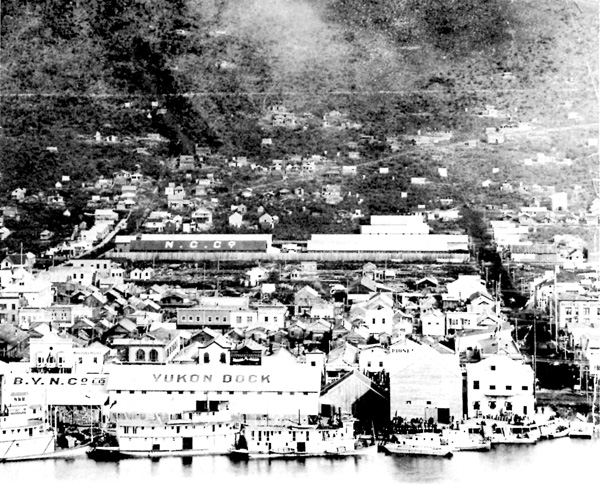
28 Bird's eye view of Dawson, showing docks, warehouses and stores
between King andd Queen streets, ca. 1902.
(Public Archives Canada, C 17015.)
|
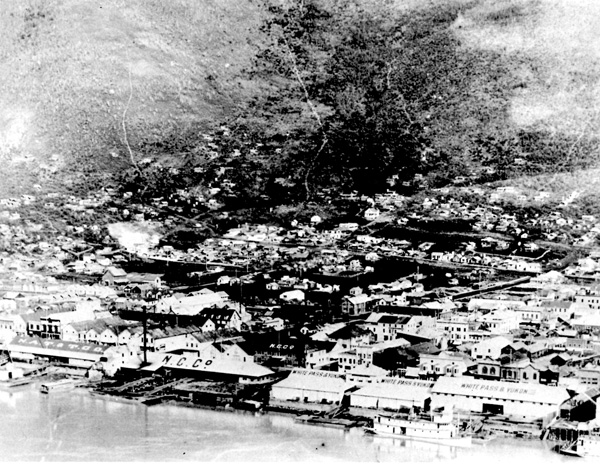
29 Northeast panorama of Dawson, ca. 1903. The main street to
the right of centre is King Street.
(Public Archives Canada, C 675.)
|
Six lumber mills operated in the town by 1899. By 1903 frame
buildings of two and three storeys had replaced log cabin structures in
the business section to such a degree that those log cabins remaining in
the city's core were singled out by one observer with a touch of
historical appreciation.4 In 1899 the first brick building
constructed entirely of local materials was erected on Third Street
between Third and Fourth avenues.5 It was a cold storage
warehouse for the Dawson Warehouse Company, and the building managed to
withstand the rigours of permafrost, the greatest hazard associated with
brick construction in the north. While the Dawson Daily News
enthusiastically heralded brick as the building material of the
future,6 only a handful more of these structures was actually
erected.
One major factor in Dawson's more respectable appearance was the
widening and macadamizing7 of the streets which served the
business core; that is, from Front Street to Third, and later to Fifth
Avenue for five blocks from north to south. By the time Lord Minto, the
governor general, arrived for an official visit in August 1900, the city
boasted five miles of graded streets planked at intersections and 12
miles of wooden sidewalks8 (see Fig. 31). The
harrowing stories of passageways clogged with mud, pedestrians and
animals (alive and dead) were now only memories (Fig. 30). With
sophisticated nonchalance, the 1901 Dawson directory described the
buggies and carriages which passed freely along the thoroughfares. "A
pleasing sight of a summer eve is to see the many handsome turnouts
together with several hundred bicyclists lining the boulevard of the
waterfront in up-to-date Dawson.9
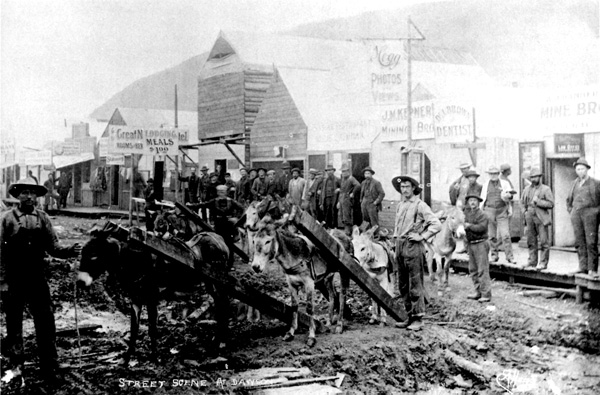
30 Dawson street scene, 1898. Each
heavy rain was a reminder of Dawon's swampy origins.
(Public Archives Canada, C 20891.)
|
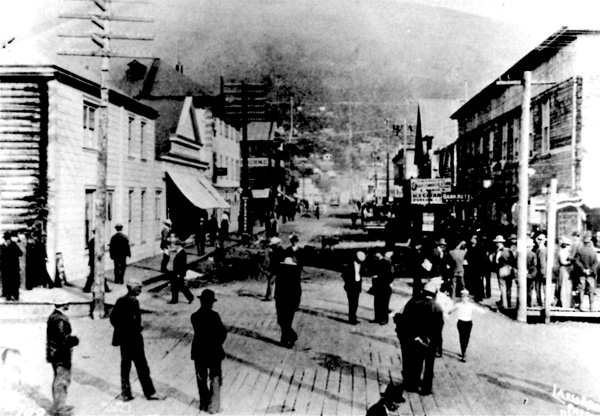
31 A major intersection: King and
Front, ca. 1900. Contrast the road conditions to those in
Figure 30.
(Public Archives Canada,
C 13416.)
|
The extended use of electric lighting was clearly indicative of
Dawson's material progress. The Dawson Electric Light and Power Company,
incorporated in 1900, replaced several smaller concerns which had
attempted, somewhat erratically, to satisfy the city's need for
power.10 By the first months of the new century, some of the
town's leading trading companies had wired their stores to produce that
"clear white light so different from the smokey yellow glare of coal oil
lamps." In that same year the entire mining district was served by the
Yukon Telephone Syndicate. Two years later, 330 telephones were reported
to be in use in Dawson.12 Since some customers along the
creeks were as far as 50 miles from Dawson, the installation of a
working telephone system was an understandable asset to business.
One improvement essential to Dawson's physical survival was the
construction of a successful drainage and sewer system with provision
for a clean water supply. The excitement of the summer of 1898 had been
marred by a serious epidemic of typhoid, as well as by cases of malaria
and dysentery, all natural consequences of the unregulated
overpopulation of a poorly drained swampy area.13 While a new
board of health made initial improvements in 1899, it was not until 1900
that adequate sewer and water supply systems were
functioning.14
Probably greater than the apprehension of widespread disease was
Dawson's fear of fire. The two huge blazes which roared through the
overcrowded business district during the winter of 1898-99 had been
ample cause for a constantly alert fire department. By 1901 the
increased subscription support of the merchant community had equipped
the department with two engines, two hose carts, two chemical engines
and a hook and ladder truck; hydrant connections were gradually extended
along major arteries.15
In 1901, Dawson had unquestionably come of age. In no section was
this achievement more visible nor more enthusiastically praised than in
the business community. In fact this group was more responsible than any
other for many of the changes which effectively transformed Dawson into
an example of respectability. Few of the awed witnesses of
post-gold-rush Dawson failed to refer to the sense of "permanency" which
pervaded the city in general and its commercial sector in particular.
Nearly all made mention of the success of Dawson's prominent merchants,
the merchants whose large investments indicated their intentions to
remain in the Klondike market.
In a special "Midsummer Edition" in 1899, the Dawson Daily News
estimated the combined capital investments of the AC Company, the
NAT&T Company and the AE Company (the three leading trading and
transportation companies in Dawson) to be $5 million.16 An
assessment of 1901 showed that a total of 13 leading business houses
were valued at sums between $50,000 and $1.8 million.17
Architecturally, the city's exterior at the turn of the century
successfully projected the image of a thriving and prosperous community.
The commercial backbone of Dawson was composed of the row of stores,
hotels, small businesses and saloons which lined the entire length of
the east side of Front Street (later known also as First Avenue),
overlooking the chain of docks and warehouses which actually bordered
the shoreline. Here the impressive emporia of most of the larger firms,
as well as many of the city's finer hotels and theatres, were located on
the "line" or boardwalk (so called because of the 12-foot-wide sidewalk
which lined one side of that very wide street). Parallel to Front Street
and immediately to the east was Second Avenue, an equally busy
thoroughfare, where transactions occurred in every field from real
estate to confections, from prostitution to embalming. The nucleus of
primary activity extended as far as Third Avenue, the street singled out
in 1902 as the general artery of the town. Fourth and Fifth avenues
consisted mainly of warehouses and residences.
Quite a separate commercial and residential district grew up at the
southern tip of the city in an area which owed its sense of isolation to
the large tract of government reserve land which separated it from
Dawson's core. South Dawson, as the quarter-mile strip was known, housed
some of Dawson's more respected small businesses by 1901. Across the
Klondike River from this suburb lay Klondike City, maligned from an
early period by its universal nickname "Lousetown." The less than
sterling reputation of Dawson's younger sister was acquired in 1901,
when the Yukon Council ordered Dawson's birds of paradise to nest beyond
the city limits. The entire flock lighted in Lousetown. Councilmen were
hard-pressed to convince the more respectable — and now irate and
petitioning — residents of Klondike City that Dawson's demimonde
had not expressly been ordered to their shores.18
Two- and three-storey frame commercial buildings dominated Dawson's
streetscapes. While both the AC Company and the NAT&T Company
favoured the simple unadorned structures erected in 1897, the most
popular type of edifice still displayed some variation on the boom-town
front. Such fronts ranged from plain rectangular shapes to elaborate
outlines with peaks, parapets, domes and balustrades, often decorated
with highly ornamental friezes and cornices, contrasting woodwork and
trim (see Figs. 32 and 33). White seems to have been the predominant
colour of building fronts, but the general effect was by no means one of
blank space. The series of flat storefronts was broken by any number of
variations on the general format of large display windows on either side
of an indented doorway. Each store had its own colourful awning, often
striped, scalloped or bearing the owner's name. Presumably these awnings
were removed in the winter to let in the little sunlight that did
appear.
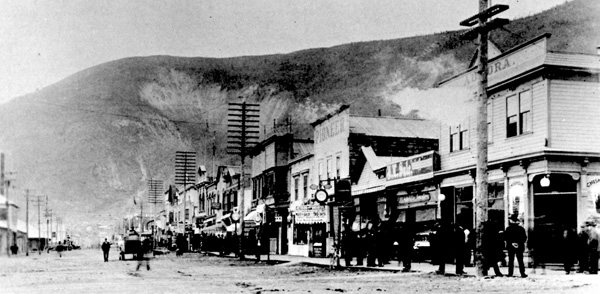
32 Boomtown architecture at its
rococo best, Front Street, 1904.
(Public Archives Canada, PA 14537.)
|
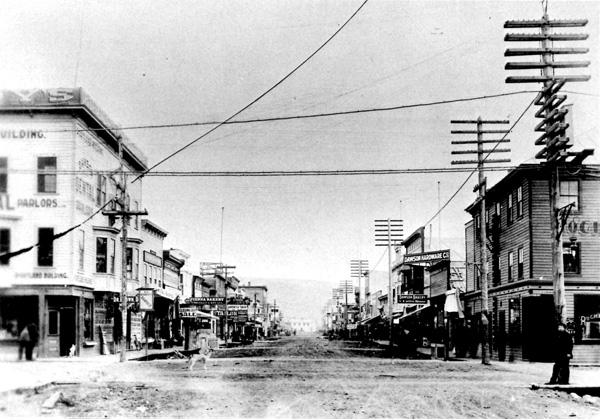
33 One of Dawson's main streets in 1904.
Second Avenue as seen from King Street.
(Public Archives Canada, C 14540.)
|
Photographs taken at the turn of the century provide contrasting
impressions of store-front signs. The majority show either letters
neatly painted on building fronts or unspectacular sign-boards affixed
over the central doorway. In one photograph, Front Street is festooned
with carnival-like banners proclaiming the remarkable bargains to be
made in various nearby shops. Perhaps Front Street tradesmen were among
the offenders singled out in a Dawson Daily News editorial early
in 1900 which complained of "those objectionable signs and banners,
especially those transparencies with lights" (Fig. 34). As Dawson prepared
for the upcoming visit of Lord and Lady Minto, the more "objectionable"
visible aspects of trade were ordered to be removed.19
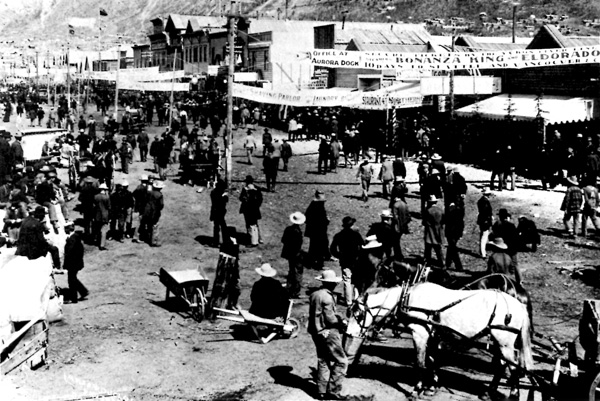
34 Front Street in 1899: "those objectionable signs and banners."
(Public Archives Canada, C 6648.)
|
In the long run, this enforced and somewhat uncharacteristic tidiness
did not prevail in Dawson. A photograph of Second Avenue taken in 1904
(Fig. 33) reveals a muddle of signs, competing with wires and lamp
standards, on rooftops and overhanging the sidewalks — true
manifestations of urban North American enterprise. One element of the
tableau peculiar to Dawson in the long rain-free days of summer was the
transaction of business outdoors. Tradesmen extended their shelves,
crates, barrels, kegs and racks beyond the display windows and out onto
the plank sidewalks. During a closing-out sale (a regular summer
occurrence over the years) the heaps of goods and "selling out" sign
boards spilled over the sidewalk to the street itself, in open defiance
of the city's legal standards of respectable appearance.
Another unique feature of Dawson's skyline was the preponderance of
huge corrugated iron warehouses scattered throughout the city. By 1901
these structures numbered nearly 50, with a total capacity of some
50,000 tons.20 Even the earliest warehouses of the AC Company
measured in size from 30 feet by 50 feet to 30 feet by 190
feet.21 A good proportion of the entire capital investment in
Dawson lay within these warehouses, as well as its means of survival for
any entire year. The very presence of these enormous buildings was,
understandably, impressive (Figs. 28 and 35).
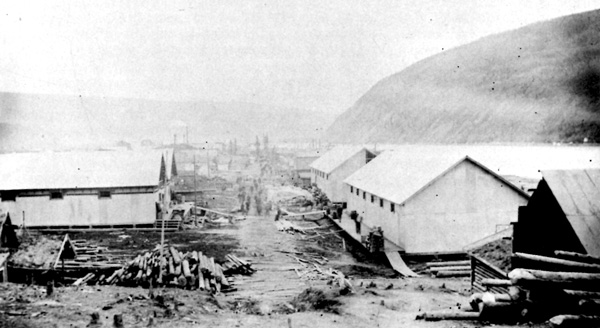
35 AE Company warehouses, ca. 1899.
(Public Archives Canada, PA 13297.)
|
When surrounded by such visible signs of prosperity, Dawson
residents, more than those of any other Canadian city, must have
continued to reflect upon the transience of fortune, the fickleness of
the paystreak. Even the most optimistic among them must have realized
just how tenuous was the validity of the city's nickname, "the Paris of
the North." Only the more cynical among them, however, would have dared
to interpret the town's newly gleaming exterior as a by-product of the
much sought-after goal of Dawson merchants, the lasting market. Without
this one promise of security no investment concern would have stayed in
that isolated northern valley.
The fact that they did stay represents the second phase in a cycle of
resource development. In proposing this theory, H.A. Innis suggests that
the phenomenon describes the slow death of a primary resource leaving in
its wake secondary industries, once urgently needed, as the basis of a
new but somewhat less productive economy.22 Given the
undoubted value of the Kondike's primary resource, as well as its
inaccessability, the capital outlay in the opening of the industry was
both extensive, immediate and necessary. The unusually high wages
offered to miners in the first year of the rush,23 the
immediate influx of established transportation and trading corporations,
the exorbitant cost of land and commodities and the immediate
construction of a rail connection all signaled heavy initial capital
investment.
In the service industries such investments could be repaid only if
increasingly efficient methods, firm markets and high prices
prevailed.24 Using Innis's hypothesis, one can appreciate the
influence of the Dawson merchant group as agents of change. Their eager
support of urban improvements was evidence of a sustained effort to
maintain business at a reduced overhead.
While operations were certainly made more efficient on many counts,
there were several basic aspects of doing business which remained
costly, to the chagrin of businessmen and, of course, of the consumers
who ultimately suffered unrelieved high prices. Rail and water
transportation companies provided increasingly good service to Dawson,
but the WPYR rates were still sufficiently high in 1901 to provoke what
was essentially a boycott of the line by both merchants and passengers
in the city.25
The lesson taught by one million dollars' worth of damage by fires
had prompted businessmen to subscribe to a good fire department.
Nevertheless, insurance rates remained high enough to be prohibitive
— 5 to 10 per cent in 1902.26 Commercial buildings in
the city core continued to be practically uninsured; risks were taken
only on stock in corrugated iron warehouses. The general opinion was
that these rates, too, were unnecessarily high.27
High insurance rates, coupled with rents which managed to reflect the
prosperity of the past rather than the present, ensured continuing high
storage rates. More than transportation, this matter of rents uniformly
affected all merchants, large and small.28 The territory's
Crown Timber and Land Agent, the official landlord of Dawson's
waterfront properties, was singularly guilty in failing to reduce the
rents of docking and storage facilities to a level in keeping with
Dawson's post-boom economy. A petition to the agent in 1904 from the
broker who had taken over the Seattle-Yukon Dock waterfront lease begged
him to consider that the contract had been made during boom times "and
certainly from a mistaken view of the permanency of the business then
prevailing." With the change in conditions, the rental value of the
property had fallen to one-third of its original value.29
For many of those who remained in the Yukon after the gold-rush,
permanency was forever an illusion; northern commerce, however
rationalized by technical progress, could never yield sustained profits
or security. For them, economic survival was possible under one
prevalent condition: consolidation. This constitutes the theme of the
history of the mining industry during the period; claims and capital
were amassed in order to apply modern technology rather than expensive
labour to the full exploitation of secondary gravels.
Commercial operations followed a parallel development. In 1901,
Dawson's business was estimated to be securely in the hands of the
following eight firms:
1) McLennan and McFeely, wholesale and retail hardware (reported to
have done the largest business of any firm in 1900);
2) The AE Company, general merchandise department store;
3) The Trading and Exploring Company, general merchandise;
4) Seattle-Yukon Trading Company, general merchandise;
5) AC Company, general merchandise;
6) NAT&T Company, general merchandise;
7) Ladue Company, general merchandise, and
8) Ames Mercantile Company, general merchandise.30
After this list had gone to press, the AC Company effected a merger
within this group, leaving no doubt as to the only solution to the
problem of duplicated overhead and services. On 1 June 1901 citizens
were shocked to learn that the AE Company, Dawson's great emporium and
owner of "the most magnificent and best appointed retail store and
offices north of San Francisco" had been taken over by the AC
Company.31 Along with it went the Empire Trading Company.
Four days later the president of the Seattle-Yukon Trading Company
arrived in town to hand over his firm — lock, stock, steamer and
warehouse — to the new company. The result, effective all the way
along the Yukon River, was the formation of two new corporations, the
Northern Commercial Company (the NC Company), which was to deal with
mercantile concerns, and the Northern Navigation Company to handle
shipping. W.D. Wood, the president of the Seattle-Yukon Trading Company,
explained his part in the amalgamation in rather magnanimous terms: "We
disposed of our holdings because we did not desire to oppose a movement
the prime object of which is to decrease the cost of living in this
northern country."32
Lois Kitchener, the historian of the NC Company, states that in 1901
no transportation company in the north broke even, and that the years
1901-03, despite appearances to the contrary, were not good ones for the
newly merged firm.33 Records are no longer available to
provide evidence for this statement. Nor do Dawson newspapers offer
confirmation, unwilling as they were to prick illusions of stability by
admitting the existence of bad times among the city's largest
investors.
While Commissioner Ross's report to the Department of the Interior
for 1902 contains the usual booster bravado on the subject of commerce,
Congdon's report in 1903 reflects seriously on the real state of
business for the majority of merchants.
Business generally in Dawson has been passing through a somewhat
critical stage. Formerly, when enormous profits were usual, men in
business made small fortunes in a year. Many of these . . . not
unnaturally concluded that increased investments meant corresponding
increase of profits, and put into business all available assets,
including those arising from excessively liberal credits . . . Business
is certainly on a more substantial basis now, although this result has
only been obtained after the unfortunate results to many former large
operators.34
An obvious feature of this state of affairs was the inevitable
decrease in Dawson's population. The depletion of high-grade gravels had
gradually turned placer mining from a labour-intensive operation into a
highly mechanized industry. While the legendary prospector of the Yukon
valley had been an independent operator, the majority of his
counterparts in 1898 were wage earners. If the widespread unemployment
of the winter of 1898-99 had not driven them back outside, the Nome
strike later that year offered them a second chance at the easy riches
and independence which had probably lured them to the Klondike in the
first place. An estimated 8,000 left for Nome over the winter of
1899-1900;35 after the mother lode had been discovered in the
Tanana district, 2,000 to 3,000 more evacuated Dawson for
Fairbanks.36 In consequence, the city's population, estimated
at 18,000 in 1898, dropped to 10,000 after the Nome discovery, to 9,142
in 1901 and to approximately 7,000 by 1903.37 With the
exception of the 1901 figure (which comes from a Dawson census) these
are approximations made by resident journalists. As such, they are
statistically unreliable but the general trend they record is
obvious.
While shrinking markets presented a setback to the whole community,
larger firms were clearly in a better position to weather the storm than
were the rank-and-file storekeepers. They had greater flexibility to
cope with changing demands and conditions for many of them were anchored
to established outside businesses.
It is therefore understandable that the NC Company of San Francisco
had sufficient capital to maintain its posts all along the Yukon River,
and could consequently profit from both the Nome and Tanana strikes. The
Ames Mercantile Company and the erstwhile AE Company, both of San
Francisco, were also able to command something of the Nome market by
opening branches there. The Pacific Cold Storage Company of Tacoma,
Washington, maintained branches in Nome, Dawson and along the river. The
NAT&T Company of Chicago and Seattle was also a long time proprietor
of a chain of Yukon River stores and trading posts. It opened branches
at Grand Forks (at the confluence of Bonanza and Eldorado creeks) and on
Sulphur and Dominion creeks in order to tap the market in the heart of
the Klondike district more fully.38 Such was the pattern of a
commercial system serving the placer gold-mining frontier. Like the
goldseekers themselves, company stores could be found at the site of the
most lucrative strikes. The operation of such branches helped offset the
inevitable rise-and-fall economic cycle of any single gold town. The
Vancouver hardware dealers McLennan and McFeely acted quickly in
establishing outlets not only in the Klondike but in Atlin and Bennett,
British Columbia, as well.39 As the initial rush through this
area died off, McLennan and McFeely closed its operations near the Yukon
headwaters to concentrate instead on the Dawson trade. All these
companies could, to some extent, offset the vagaries of the Dawson
market by operating branches throughout the territory.
In several articles of correspondence in 1903 and 1904, the Dawson
Hardware Company referred without regret to the slump in shelf hardware
sales. A conversion in mining equipment occurred as the industry
gradually turned to hydraulic operations. Like its competitor McLennan
and McFeely, Dawson Hardware was large enough to adapt itself to the
transition by producing and selling larger items of
machinery.40
Dawson, the reigning "gold rush town," unhappily surrendered her
title to Fairbanks in 1903. In one important aspect, however, the older
city did benefit from this rush, and its wholesale merchants were the
men to reap the profits. Dawson's short shipping season necessitated
year-round storage, which in turn produced the aggravating problem of
slow-moving or dead-end stock which was impossible to unload on a
decreasing population. A sudden strike in the north, with its
concomitant and immediate demand for all sorts of provisions, put Dawson
jobbers briefly in the fortunate position which their Seattle and
Vancouver antecedents had occupied half a decade earlier. While this
later rush was neither as large nor as sustained as the Kondike one had
been, the immediate impact on overstocked merchants was a healthy one.
Dealers whose surplus goods were American were especially fortunate, for
their stocks could enter Alaskan territory duty-free.41 In
1905 there were 24 bonded warehouses in the city with goods destined for
Fairbanks. The customs collector at Dawson claimed that year that the
previous season's trade with Fairbanks had earned Dawson wholesalers no
less than $750,000.42
The city's wholesale-retail firms made the most of Dawson's natural
position as the entrepôt for the Klondike hinterland. While
dealing in some retail trade themselves, an increasingly large part of
their business was ordering and shipping complete lines of goods from
outside for resale to retail outlets in Dawson and the creek
centres.43 At the same time, it was more convenient (if not
necessarily cheaper) for these merchants to buy their goods from local
wholesale dealers. They could at least count on suitable lines of
commodities, insured storage and more charitable terms of payment than
they might obtain from outside firms. Above all, the worrying trials of
long-distance ordering and shipping could be left to those larger
businesses better equipped to recover or absorb possible losses.
Whatever advantages the system might have offered the retailer, his
permanent subjugation to the jobber or wholesale supplier, local or
distant, was universally uncomfortable. In an article defending a
retailers' purchasing cooperative in Ontario, the Canadian
Grocer, always a friend of the individual merchant, sympathized with
the retailer's difficult position.44 The lot of the small
merchant in the shadow of the large wholesale firm was brought sharply
into focus by the Nugget during its war against the WPYR in July
1901. Not only did the WPYR charge more than the traffic could possibly
bear, the crusading Nugget claimed, but it gave preferential
rates to certain wholesale shippers. Although its charges were never
substantiated, the paper cited the firms McLennan and McFeely, Palmer
Brothers (general merchandise, wholesale and retail) and T.G. Wilson
(wholesale groceries) as examples.45
The percentage of Dawson's wholesale or jobbing trade which actually
went to the large multi-purpose companies, to the wholesale-retail
dealers in specific fields (hardware, dry goods, groceries, meats or
drugs) or to the amorphous group of wholesale importers and commission
merchants ("do you want to buy or sell anything?") can only be guessed
at. The only generalization one can hazard is that the initial
distribution of goods in Dawson became the prerogative of an
increasingly limited number of local jobbers.
The move toward consolidation within the Dawson merchant community is
not to be interpreted as a simple and drastic reduction of the number of
merchants participating in the trade. On the contrary, the number of
merchants in the city directories of 1901, 1902 and 1903 is overwhelming
and a numerical decline is not uniformly evident in this period.
(See Appendix G. Note, for instance, the number of grocers and
produce dealers, as well as hardware merchants.) One striking figure is
that of 135 merchants and traders without definite fields or locations
of business whose names appear in the alphabetical list of Dawson
residents for 1901.46 In what way these men and women did
their business we have little or no indication. The number of these
mysterious traders drops sharply to 41 in 1902; by the time the 1903
lists were prepared, they seem to have disappeared altogether. Those few
names which reappear do so in connection with well-defined trades in
groceries, hardware, second-hand goods or confectionery.
The incorporation of the city of Dawson in 1902 was undoubtedly the
prime cause of their disappearance, for with it came taxes and enforced
licensing of all businesses. Especially significant in this case was the
increase in fees for transient traders47 from $150 per annum
to $500.48 The annual spring scramble from the upper Yukon
River to supply Dawson with its first perishables was a lucrative
business, and these traders represented a get-rich-quick system which
seemed to show little regard for contributing to the growing community.
License fees were constantly evaded, but by June of 1902 the law had
caught up with the most blatant offenders, with the full support of the
outraged merchant community.49 By August, the heavy license
fee was uniformly imposed. Since these scow traders were not residents
of the city, there is no official record of their number, and no
indication of their reaction to the unavoidable fees. One suspects that
they, like the small permanent traders who suddenly fled Dawson, took
this as provocation to push on to richer frontiers.
Two possibilities exist to explain the next moves of these traders.
The more probable of the two is based on the idea that most individual
entrepreneurs did not last long on the frontier. They were likely to
return, richer or poorer, to the "civilized" heartland they had
originally left. This is especially probable in the cases of those
adventurers who had had no previous commercial experience. Mr. Bob
Bloom, once of Dawson and Fairbanks and now of Seattle, has suggested a
second possibility. Mr. Bloom was one of those Dawson traders who did
survive incorporation, but who sold out his hardware stock to join the
rush to Tanana, not as a merchant but as a miner. Bloom claimed that the
true northern trader was merely marking time, buying and selling to
support a much more fundamental quest. When the moment came, Bloom felt
little remorse in leaving Dawson, but he was to turn again to the life
of the general trader many years later in Fairbanks. Just as the
Alaska-Yukon directories do not reveal the cycle of Bloom's frontier
occupations, so we are left to imagine how the lives of those on its
pages labelled simply "trader" or "miner" must have passed through
similar patterns.
A third explanation of the fate of Dawson's floating merchant
population, and the most popularly accepted one, is that they moved
en masse to the creeks, in particular to Grand
Forks.50 This is hard to accept for a number of reasons.
First, Grand Forks was itself incorporated as the town of Bonanza in
1902; thereafter it imposed its own increases in licensing fees,
including a fee of $500 for transient traders.51 Second, the
directories for the years 1901-03 show very little increase in the
number of merchants doing business in Grand Forks (see Appendix H).
Third, none of the 135 small Dawson merchants and traders listed in
1901, or the 41 listed in 1902, appear in subsequent listings for
Bonanza in any capacity.
For various reasons, a steady amount of business was done on the
creeks. The activity at Bonanza in particular was enough to cause some
Dawson tradesmen to take notice, for the creeks seemed to be growing
progressively more independent of the centre.52 In the light
of this development, the commercial relationship between Dawson and the
surrounding creeks bears further examination.
Bonanza, located some 12 miles from Dawson, was able to offer most of
the services necessary to its own survival. As the largest of the creek
towns (its population was 4,133 in 1900),53 Bonanza was
described by one visitor as being actually busier than Dawson itself.
From the directories, it is obvious that no other creek offered the
variety of services found in Grand Forks. Men working on such distant
creeks as Sulphur, Dominion and Gold Run, well over 30 miles from either
Dawson or Bonanza, had to purchase their supplies at one of these small
creek centres.
Despite the presence of some local merchants on the more distant
tributaries, several diaries and personal accounts report long trips
(albeit only annual or semi-annual ones) into Dawson to buy the season's
supplies. One such account by a miner from Sulphur Creek, 35 miles from
Dawson, speaks resignedly of the muddy June trails which stretched the
journey into a two-day trip. Lower food prices and the opportunity of
exchanging the drudgery of mining for Dawson's urban excitement made the
long trip worthwhile.54 After a 25-mile trip into Dawson to
place his yearly order, one miner commented with unconcealed awe on
"some American Trading Company in which you could buy almost anything
you needed."55 While complaining bitterly about prices, the
miner marvelled at the rapid delivery of goods. "I'd hardly be there
myself before the store's dog-sleds would arrive with all that I
ordered. The whole supply would be delivered to the door without any
extra charge."
Until 1901, travel on the creek roads was arduous; consequently the
cost of freighting goods was outrageously high. Summer rates varied from
25 cents to $1 per pound, depending on the distance of the destination
from Dawson. Winter rates dropped by one-half, since the frozen trails
were considerably easier to negotiate.56 The miner from
Sulphur Creek quoted above tells us that an article which cost 50 cents
in Dawson was worth $1.50 once it had been transported into
camp.57 According to H.A. Innis, it was possible to pay ten
times the Vancouver or Victoria price for an article just to transport
it to an outlying creek.58 As the transportation of heavy
equipment such as steam thawers, pumps and boilers became increasingly
necessary, the annoyance of bad roads intensified.
As early as 1899 the Yukon Council had realized the need for better
roads, but an adequate network was not completed for several
years.59 By 1901 there were daily stage connections to the
creeks, and the 25 cents per pound summer rate to Grand Forks had fallen
to a more reasonable 3 cents per pound.60 Dawson's business
with the creeks that year was active enough to support eight freighting
companies on the circuit. In 1903 one visiting writer spoke grandly of
the fine government highway to Hunker Creek and of the many six-horse
stages that ran frequent trips into the territory. "Hence," he
concluded, "Dawson takes on metropolitan airs, and considers herself the
new metropolis of the far north and Yukon valley."61
Not all the general merchants on the creeks resigned themselves to
Dawson's superiority. As roads improved and rates fell, so their ability
to compete increased. Dick Craine of the Last Chance Hotel, General
Store and Museum on Last Chance Creek put an advertisement in the
Dawson Daily News late in the winter of 1900, announcing that "I
will compete in prices with any house in Dawson. Come and get my prices.
Pack train and delivery in connection. Give me a chance on your
freight."62 About a year later, the Nugget referred
with a certain sympathy to the small Dawson merchants whose businesses
were stagnating because of increased competition from the
creeks.63 According to the Nugget, the success of
these outlying traders was largely due to the exorbitant storage rates
charged in Dawson at the time, rates which creek traders were able to
avoid if they met their consignments right at the docks. No evidence
remains, however, to indicate the ultimate success of these creek
merchants in avoiding the Dawson wholesale middlemen.
The sphere of Dawson's commercial influence extended well beyond the
Kondike River and its tributaries. By 1902 the 307-mile
Dawson-Whitehorse road had been completed.64 To the Dawson
supplier, this meant not only that winter goods would have a better
chance of arriving intact but also that the completed road would give
rise to an uninterrupted chain of road-houses to be stocked. Needless to
say, Whitehorse jobbing grocers had much the same thoughts of possible
gains. Fort Selkirk, at the junction of the Pelly and Yukon rivers, some
175 miles from Dawson, seems to have emerged as the dividing point
between the Dawson- and Whitehorse-dependent posts.
While the division of spoils of the Yukon River trade was fairly
clear-cut, spheres of influence along the tributaries were more hazily
drawn. The Stewart River posts are a good example of this. An entire
general store outfit (for the Stewart River Trading Company) and
numerous individual consignments were sent out by steamer from Dawson in
1902.65 At the same time, the North West Mounted Police
detachment on that river was supplied through Whitehorse. The year 1902,
incidentally, marked the first occasion on which the Mounted Police
stocked their posts with goods "from home corners," as the quartermaster
put it in his announcement to the Dawson Daily News.66
This must have come as good news to both Dawson and Whitehorse companies
which might acquire contracts.
As the railhead, Whitehorse enjoyed a certain degree of commercial
activity on its own. It was never as wealthy as Dawson, for there were
no mining operations in the immediate vicinity. Yet a strike at nearby
Kluane Lake in the fall of 1903 provoked a great deal of excitement
among Whitehorse residents. The new strike was located on a headwater
lake of the Yukon River, just over 100 miles west of Whitehorse by
overland trail. Since Whitehorse, as the railhead, received freight on a
continual basis all winter long, it was in a good position to capture
the Kluane market. At this point the general merchandise trade in that
community was well under control in the hands of four major dealers. In
conjunction with a handful of specialists in hardware, men's clothing
and groceries, this group monopolized the services in the new camp.
Whitehorse itself was virtually deserted that fall.67 Its
citizens had spent too long a time as mere spectators to others'
stampedes: they were determined to have an active hand in this one.
The propitious effect of the Tanana strike on Dawson suppliers has
already been mentioned. Through a highly controversial point of Canadian
customs policy, these same suppliers enjoyed a continually strong market
in those downriver camps which, though in American territory, were
closer to Dawson than to Saint Michael. Merchants in these communities
(such towns as Eagle, Chicken, Steel Creek and Ramparts) soon became
frustrated when they tried to ship in American goods. The shortest route
was undoubtedly the upper river one; that is, the railroad through
Canadian territory. Canadian bonding procedure required that duty on
American goods be paid, to be refunded when such goods re-entered
American territory. But after coping with miles of red tape in the
customs office at Victoria, the receiving merchants found the refund
almost impossible to extract. American goods were still a large part of
Dawson's stock at this time (see "Satisfying the Sourdough
Appetite,") and victimized merchants soon discovered that it was much
simpler to buy from Dawson wholesale dealers. An added advantage was
that these goods could enter Alaskan territory under an Amerian
regulation as "American goods returned duty-free."68
Ironically, customs irregularities had helped to flood Dawson with
American goods in the first place. Now it was Dawson's turn to benefit
from similar confusion on the other side of the border.
If H.A. Innis's hypothesis that the initial Klondike boom period was
followed by a time of economic adjustment is accepted, then one can
legitimately view commercial activity in the period 1899-1903 in terms
of reduction and consolidation. This trend was most profitable for the
larger wholesale and retail establishments which could better adjust to
the change. The diversity of their activities would ultimately be the
factor which left to them the fulfillment of Dawson's role as Klondike
metropolis. Conversely, such commercial progress was apt to be
disastrous for the plethora of now-redundant traders and small merchants
who had once jammed Dawson's streets, for their stake in metropolitan
prosperity was a peripheral one indeed.
Such an insistent stress upon commercial consolidation might create
an unnecessarily bleak picture unless a related view of Dawson in this
period is also considered, for during these same years Dawson blossomed.
A number of experienced and specialized storekeepers had built up known
and respected businesses by maintaining high quality in their
commodities and by stocking lines as varied as could be found along any
main street outside. Variety and quality were more than anyone had dared
hope for in the rough and ready days of "tent city" hawkers. They were
qualities which Dawson merchants learned to provide.
|

